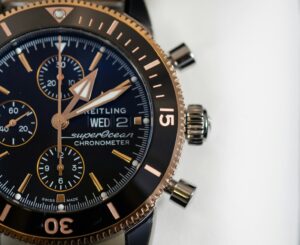I’ve always been fascinated by how everyday objects evolve, and few items showcase this as dramatically as men’s watches. From their humble beginnings in the late 19th century, when a Swiss company first mass-produced wristwatches for the German Imperial Navy, to becoming a symbol of adventure and precision, the evolution of men’s watches is a captivating journey.
This transformation was notably accelerated during World War I, a period that redefined their use out of sheer necessity. Soldiers in the trenches synchronized their watches to coordinate attacks, turning these timepieces from simple fashion accessories into vital tools for survival. This need sparked innovations that propelled the functionality and design of men’s watches into new realms, making them indispensable in both daily life and critical situations.
Today, whether it’s scaling the highest mountains or diving into the ocean’s depths, men’s watches stand as a testament to human ingenuity and the relentless pursuit of precision and reliability. Let’s delve deeper into how these time-honored companions continue to tick alongside our own adventures.
Early Beginnings of Timekeeping
The Emergence of the Clockwatch
The journey of men’s watches begins with the invention of the clockwatch in the 16th century. These early models, often celebrated as the ancestors of modern timekeeping devices, were primarily created to fulfill the needs of town watchmen. These early timekeepers were bulky and predominantly crafted for utility. The clockwatch paved the way for more sophisticated mechanisms, enabling more accurate timekeeping essential for daily scheduling and special events. Innovations like the temperature compensated balance wheels and the balance spring dramatically enhanced their accuracy. These advancements laid the foundation for all future watchmaking innovation.
Transition to the Pocket Watch
By the 19th century, the clockwatch evolved into the pocket watch, a more compact and portable design that symbolized status and precision. Pocket watches became an essential accessory for 19th-century gentlemen, often tethered by a leather strap or tucked into a waistcoat pocket. This period marked the beginning of watch production on a larger scale, thanks to the advent of mass production techniques. The pocket watch remained a staple in men’s fashion well into the early 20th century.
It was during this era that watchmaking companies began to explore the possibility of attaching these watches to bracelets, leading to the creation of the first wristwatch – a design initially thought to be exclusively worn by women before it became popular among military men during World War I for coordinating troop movements. This shift underscored the evolving needs and styles of timekeeping in a rapidly changing world.
Innovation Through Necessity
Technological Advancements in Accuracy
The quest for precise timekeeping has driven watchmaking innovation significantly. Initially, pocket watches in the 19th century were the epitome of watchmaking artistry, reflecting social status alongside functionality. However, as watches transitioned to the wrist in the 20th century, the demand for accuracy intensified, especially in contexts requiring synchronization like military operations and aviation. Innovations such as the balance spring, introduced by Abraham Louis Breguet, and shockproof balance pivots, enhanced the resilience and accuracy of watches under diverse conditions. The introduction of temperature compensated balance wheels marked a pivotal turn in enhancing watch accuracy, ensuring that watches kept time within a few seconds’ variance despite temperature changes.
Military Influence on Watch Design
The significant shifts in watch design are widely attributed to military needs during World War I. As coordination of troop movements became crucial, the practicality of pocket watches diminished, giving rise to purpose-built wristwatches famously known as “trench watches”. These watches featured luminous hands for easy reading in low-light conditions and a more robust construction to withstand battlefield conditions.
German naval officers and other military personnel required watches that could maintain functionality amidst the rigors of war, which propelled the development of features like water resistance and hardened glass. Post World War I, these military-inspired designs slowly permeated into civilian fashion, with men’s watches adopting rugged features that combined functionality with style, paving the way for the wide array of men’s accessories seen today in the watch industry.
Rise of the Wristwatch
From the Trenches to Fashion Statement
The transformation of the wristwatch from a strictly military tool to a quintessential element of men’s fashion began during the First World War. Initially designed for the practical purpose of synchronizing troop movements without exposing soldiers to unnecessary danger, wristwatches, or “trench watches” as they were known, featured rugged construction and luminous hands for visibility in low-light conditions. Their adoption by military men marked a pivotal shift. Post-war, these watches began to gain prevalence among civilians, attracted by their practicality and the aura of bravery they conveyed.
However, it wasn’t just about practicality; the wristwatch’s evolution into a fashion statement was bolstered by notable figures like Louis Cartier. He designed the first purpose-built wristwatch for his friend, early aviator Alberto Santos-Dumont, making it both a tool for timing flights and a stylish accessory. This partnership highlighted how functionality and elegance could coexist, setting a trend for the watch industry to blend utility with luxury, thereby transforming wristwatches into men’s accessories coveted across various strata of society.
Moreover, Hollywood and global icons sported wristwatches, cementing their status as symbols of sophistication and essential pieces in men’s fashion. Institutions such as the Waltham Watch Company and Patek Philippe continued to innovate, pushing the boundaries of what a wristwatch could offer, transitioning the perception from a simple timepiece to a signifier of personal style and technological prowess.
Introduction of Water and Dust Resistance
As wristwatches transitioned from the trenches to everyday wear, the need for more resilient models became apparent. Early watches, particularly those crafted for military use, were engineered to withstand tough conditions, yet standard models often succumbed to common elements like water and dust. This led to revolutionary changes in design and materials used, marking the beginning of water-resistant and dust-proof wristwatches in the watch industry.
In 1926, the Rolex Oyster was introduced as the first waterproof wristwatch. It featured a hermetically sealed case which provided the much-needed protection against water and dust, paving the way for watches that could be worn in various challenging environments. This innovation was not just about durability; it also enhanced the overall functionality and longevity of wristwatches, boosting their appeal to a wider audience.
The evolution continued with brands like Omega and Cartier, which developed seals and gaskets that further improved resistance, allowing men to wear their watches during activities where exposure to elements was inevitable. These advancements were crucial as they not only enhanced the practical aspects of wristwatches but also helped in maintaining their elegance and precision in timekeeping. Such traits were essential, as they firmly positioned wristwatches as indispensable components of men’s accessories, capable of withstanding the demands of both adventurous and everyday endeavors.
Technological Milestones
The Quartz Revolution
The rise of the quartz wristwatch in the late 1960s marked a pivotal shift in the watch industry, famously referred to as the “quartz crisis.” Once Seiko introduced the first quartz wristwatch, the Seiko Astron, on December 25, 1969, the landscape of timekeeping transformed dramatically. This innovation enhanced watch accuracy exponentially, as quartz watches could keep time with a precision unheard of in mechanical watches, deviating by only a few seconds a month.
Quartz technology utilizes a quartz crystal oscillator to measure time, dramatically improving accuracy over the balance wheel mechanism used in traditional mechanical watches. The impact on the watch industry was profound, leading to a rapid decline in the production of mechanical watches and reshaping global market dynamics. Many established watchmaking companies faced severe challenges, while others adapted by incorporating quartz movements into their product lines.
The Digital Watch Era
By the late 1970s, another significant innovation emerged: the digital electronic watch. This era began with the introduction of the first digital watch by Hamilton Watch Company in 1972, which featured a red LED display that illuminated the time at the push of a button. The transition from analog to digital displays revolutionized how people interacted with their watches, offering not just timekeeping but also additional functionalities such as stopwatches, countdown timers, and backlight features.
The proliferation of digital technology in watches paved the way for the development of more complex timekeeping technologies, including the first radio-controlled wristwatch and the integration of computer-like features in modern smartwatches like the Apple Watch. Digital watches catered to a growing consumer demand for multifunctional devices, influencing both the evolution of men’s watches and the broader spectrum of portable electronic devices. This period emphasized the shift from purely mechanical expertise to an electronic-driven approach in watchmaking, broadening the scope and appeal of men’s accessories in the world of horology.
Modern Watch Innovations
The Advent of Smartwatches
I’ve observed that the introduction of smartwatches marked a significant turning point in the evolution of men’s watches. These modern devices blend traditional timekeeping with advanced technology, catering to a generation that values connectivity and multifunctionality. Notably, the Apple Watch, released in 2015, exemplifies this shift. It incorporates health monitoring, mobile connectivity, and customizable interfaces into a classic wristwatch format.
Smartwatches initially gained traction after the successful Kickstarter campaign for the Pebble watch in 2012, which raised $10.3 million. Innovations didn’t stop there. Modern smartwatches include features such as GPS tracking, heart rate sensors, and even the ability to make calls, essentially miniaturizing the functionality of a smartphone into a wearable device.
Coupled with increasing consumer demand for gadgets that seamlessly integrate with daily life, smartwatches have carved a niche in the watch industry. They are no longer just timekeeping tools but essential lifestyle devices that reflect the wearer’s personality and tech-savviness.
Environmental and Sustainability Trends
Moving forward, it’s clear that sustainability has become a crucial aspect of watch manufacturing. Watch companies are now embracing eco-friendly practices, recognizing the growing consumer interest in environmental impact. For instance, certain brands have started using recycled materials for the watch casings and bands and adopting solar power to reduce battery waste.
In my analysis, I find that the trend towards sustainability is not just a fad but a reflection of a broader shift across industries towards more responsible production practices. Watchmakers are experimenting with biodegradable materials and leveraging renewable energy sources in their manufacturing processes, which not only appeals to environmentally conscious consumers but also decreases the ecological footprint of their products.
Moreover, the packaging of watches has seen a transformation, with most companies opting for recycled or sustainable materials. This holistic approach to sustainability in the watch industry not only helps in conserving natural resources but also enhances brand loyalty among consumers who prioritize environmental values.
Final Thoughts
Exploring the journey of men’s watches has revealed a fascinating blend of innovation, style, and technology. From their origins as practical military tools to their status as modern fashion icons and technological marvels, watches have continually adapted to meet the changing needs and tastes of society. Today, they not only tell time but also tell much about the wearer’s personality and lifestyle choices.
As we look forward, the evolution of men’s watches will likely continue to mirror technological advancements and cultural shifts, ensuring that the wristwatch remains a vital accessory in the fabric of global culture. Whether through sustainable practices or tech integration, the future of watches is as promising as its storied past.
Other suggested articles:



